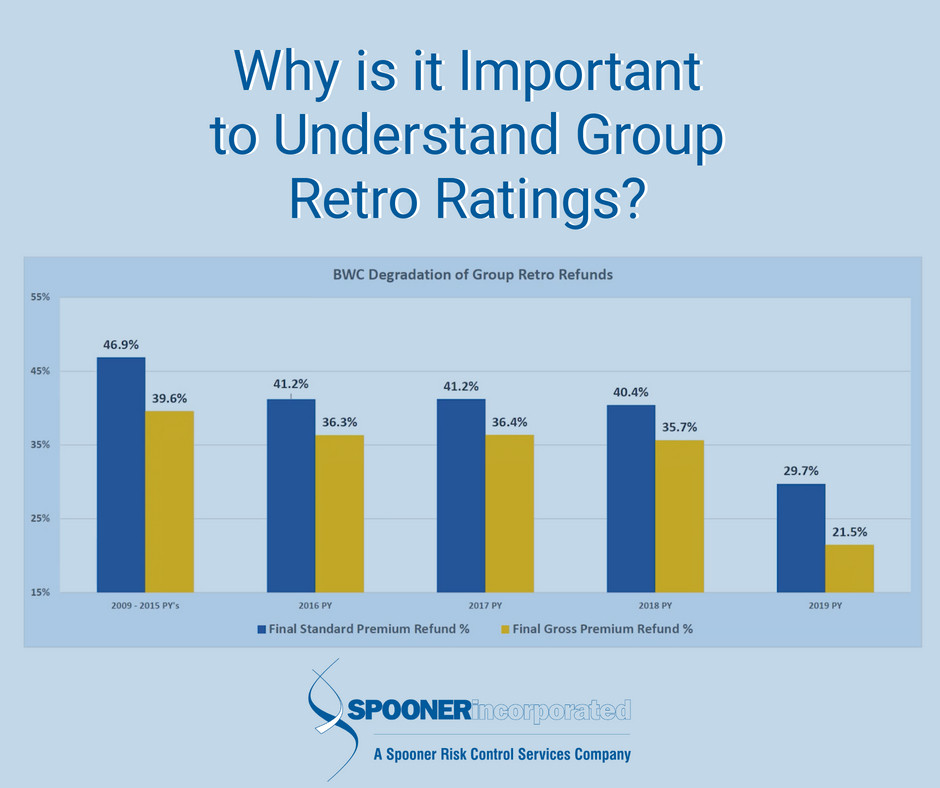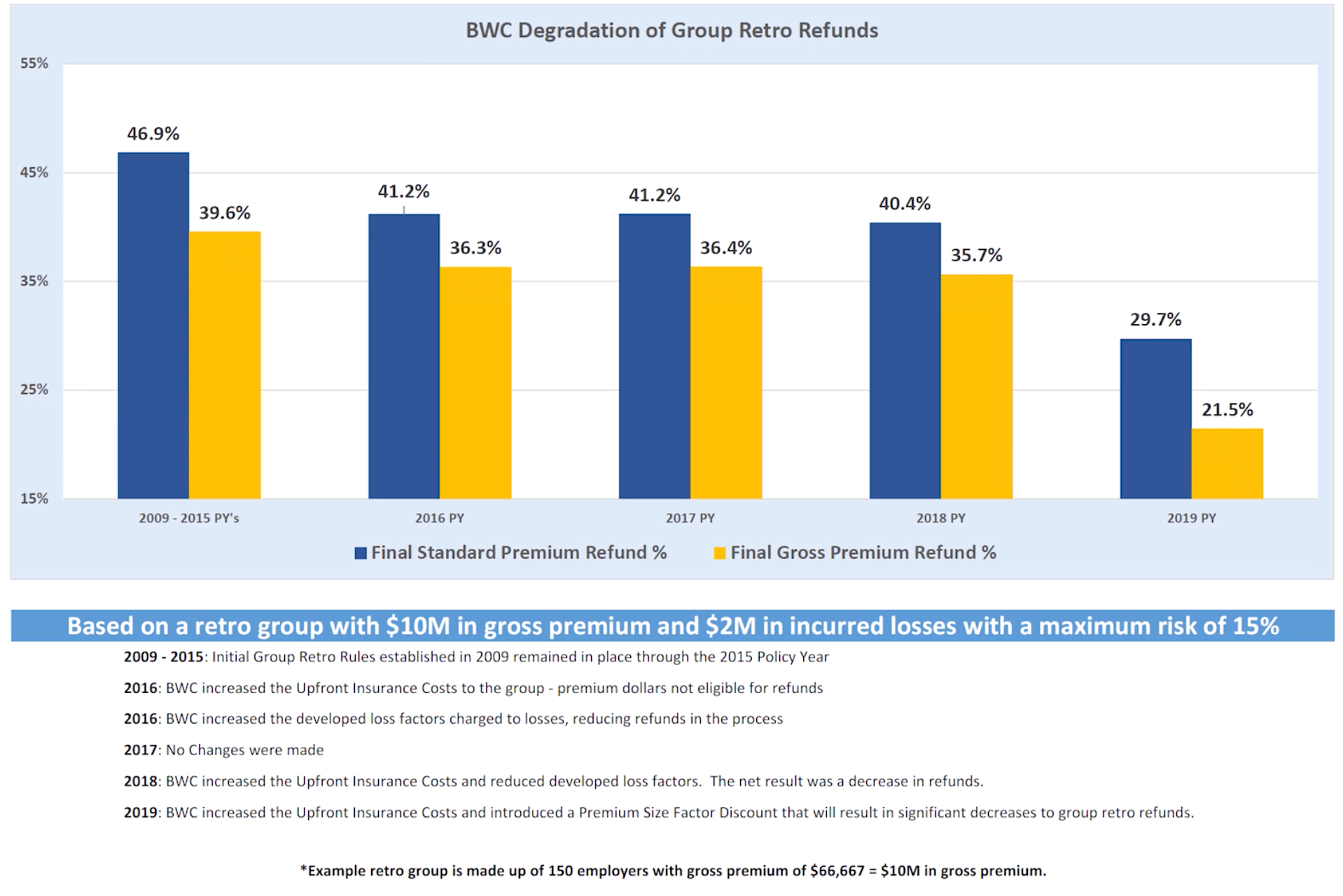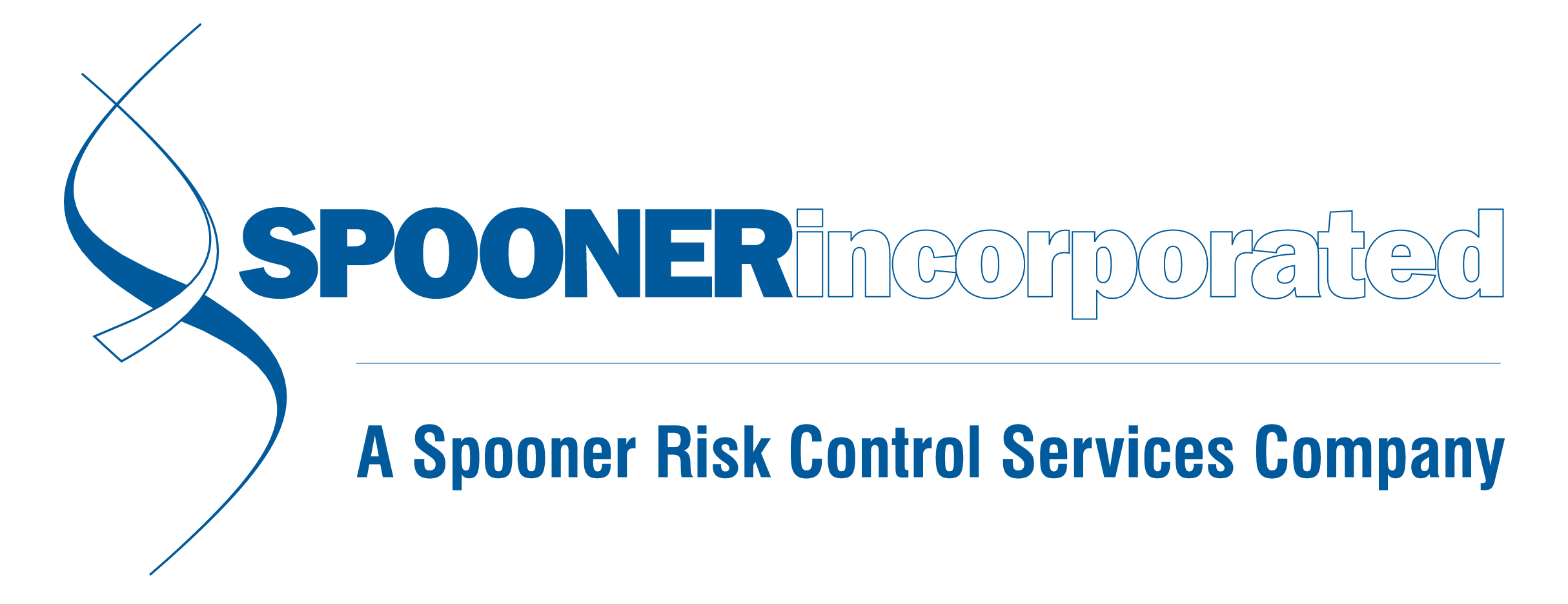Blog
Why is it Important to Understand Group Retro Ratings?

Group retro is a relatively new incentive program designed to help Ohio employers keep their workplace safe. In 2009, the Ohio BWC created group retro, and since then it has worked exceptionally well for employers who either do not have a group rating option or that have the opportunity to get more premium back from this program. However, there have been some changes made to the rules and regulations that structure the group retro rating that can affect Ohio employers.
Understanding Group Retro
The first this that you, as an Ohio employer, need to understand is what the percentages of refunds are in the group retro program. In the graph, you can see the blue columns represent the standard refund. The standard refund is based on your premium minus the BWC admin fee.
If your company pays $100,000 in premium, the BWC admin fee is roughly $15,000, so that is an $85,000 refund.

The yellow columns represent the premium that is actually paid. This is a more accurate representation of the refund you will receive from the group retro program.
This is why it is important to know if any projection is a standard or gross refund. Otherwise, you may be left thinking you would get a larger refund than you actually will.
How has Group Retro Changed in 2019?
When it comes to the 2019 policy year, the BWC has been giving some upfront discounts for premiums, which is a good thing for some. However, this will also affect group retro employers because the amount of premium in the pool will lower. Most group retro pools have a standard loss run, or they are going to assume losses. This ultimately leads to you not getting the same percentage as before.
It's very important to make sure when you're evaluating group retro, that you understand these changes and how they will affect you. You need to understand where the percentages are projected to be and what they will actually be.
There is a lot to keep up with as the rules and regulations are always changing. That is why Spooner is here to help Ohio employers stay on track and know exactly what they are doing with their group retro refunds. If you have any questions, contact us at Spooner Inc. today or visit our site for more details.

Recruiting Services Now Available to Spooner Clients
Posted By Brandy King
November 17, 2025
Category: Recruiting, Hr, Hiring
Earlier this year, we added a seasoned recruiter to our growing team of experts! Samantha Lafollette comes to us with over ten years of experience in the staffing and recruiting industries and also serves as the Northeast Ohio Area Director of the Ohio Staffing & Search Association. SuretyHR’s recruiting services can be utilized by any of our clients trying to find the right candidates for open positions. We can help evaluate your needs, develop a job description and implement a recruiting plan, handle interview scheduling and assist your team in narrowing down the candidate pools. Our flexibility and competitive fee structure could be exactly what your organization needs to enhance your in-house resources and find the best person for the role. To learn more about our recruiting services, please contact Samantha LaFollette directly
Cleveland Bans Inquiries on Applicant Salary History
Posted By Brandy King
November 14, 2025
Category: Hr, Compliance, Human Resources, Payroll, Cleveland, Ohio, Hiring, Recruiting
Cleveland’s City Council approved a measure earlier this year prohibiting prospective employers from inquiring about an applicant’s salary history, and requires employers to include salary ranges in job postings. The new ordinance that became effective on October 27, 2025, applies to all Cleveland employers with 15 or more employees. The City of Cleveland is the latest of many municipalities (and even some states) across the U.S. that have passed similar laws in an effort to promote pay equity. Columbus passed a similar ordinance that took effect in 2024. Cleveland’s ordinance still permits discussing salary expectations with applicants, and doesn’t apply to applicants for internal transfer or promotion, salaries for positions set by collective bargaining agreements and governmental employers, other than the City of Cleveland itself. Considering the ordinance fails to define “salary range or scale,” complying with the new ordinance may leader employers to questions that don’t yet have answers. Employers found in violation of the ordinance may face civil fines up to $5000, depending on the number of violations within the last five years. If your business is based in the City of Cleveland and you have questions about how this may impact you, reach out to the SuretyHR team. If we aren’t able to directly answer your questions, we can engage our HR and legal partners to help you find the right
Year-End HR To-Do List
Posted By Brandy King
November 14, 2025
Category: Hr, Human Resources,
The final quarter of each year can be frustrating for HR departments and managers, as many companies choose to freeze their budgets this time of year. However, there are plenty of ways you can prepare for next year without much, if any, investment in 2025. Compliance: Make sure your organization has completed (and documented) required annual trainings, professional licenses are renewed, trade organization memberships renewed, etc. Review employee classifications, personnel files, etc. Compensation package review: Review pay structures for both hourly and salary, as well as benefits packages. You can use market comparisons, feedback from former employees’ exit interviews, and feedback from current employees to ensure you’re staying competitive. Remember: proactively paying employees what they’re worth is often easier (and less costly) than trying to match or beat a competitor’s offer to get them to stay put. Workforce Planning: Leadership should discuss potential for employee training for all levels of staff. Look back on the issues that have come up this year. What kind of knowledge and skills could help your staff avoid those pitfalls next year? Your local Chambers of Commerce, trade organizations, and consulting firms may have a lot more to offer than you realize! Employee Communication: Keep staff informed about important year-end info including benefit changes, holiday schedules, and tax documentation. It’s always a good idea to re
Contact
28605 Ranney Parkway
Westlake, Ohio 44145
Phone: 440-249-5260 ext. 153
Hours: 8AM to 5PM

